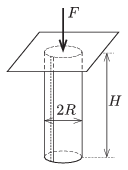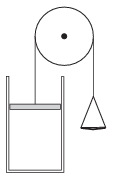KöMaL Problems in Physics, October 2014
Please read the rules of the competition.
Show/hide problems of signs:
 |
Problems with sign 'M'Deadline expired on November 10, 2014. |
M. 344. Paper tubes are made from A4 sheets of paper, such that the shorter sides of the paper are glued together (overlapping approximately a 1 cm wide stripe). Placing the tubes to a horizontal tabletop and applying a load along its symmetry axis, examine at which load will the tubes collapse. How does the critical load depend on the height of the tube?

(6 pont)
 |
Problems with sign 'P'Deadline expired on November 10, 2014. |
P. 4660. What can you observe if you look through a piece of densely weaved tulle curtain, or through the fabric of an old-type (made of silk) open umbrella and watch a distant light source?
(3 pont)
P. 4661. A car and a lorry moves along two straight perpendicular roads towards the cross-roads. The speed of the lorry with respect to the car is 90 km/h. The speedometer of the car reads 72 km/h. At the instant when the speeds were measured the lorry was 600 m and the car was 800 m from the cross-roads. Which vehicle reaches the cross-roads sooner, if both move uniformly?
(4 pont)
P. 4662. The goal-keeper is just about to kick off the ball. The kick lasts for \(\displaystyle \Delta t=0.01\) s, during which the goalkeeper exerts an average force of \(\displaystyle F=850\) N on the ball lying on the ground. If there is no air drag, the kicked ball would reach the ground in \(\displaystyle t=3\) s and it would be \(\displaystyle \ell=45\) m further.
\(\displaystyle a)\) What is the greatest height that the ball could reach?
\(\displaystyle b)\) According to the official rules of association football the mass of the ball must be between 410 g and 450 g. Is the match played according to the rules?
(4 pont)
P. 4663. A rigid rod of mass \(\displaystyle M\) can rotate about a horizontal axle which is attached to the rod at its trisecting point. A point-like object of mass \(\displaystyle m\) is attached to the end of the rod closer to the axle, and a pan of negligible mass is attached to the other end. The rod stays at rest and is horizontal.
What is the initial speed of the object of mass \(\displaystyle m\) if another object of mass \(\displaystyle m\) is dropped into the pan from a height of \(\displaystyle h\)? The dropped object stays in the pan, and friction is negligible.
(5 pont)
P. 4664. Mr. Tompkins (The chief character of the book titled Mr. Tompkins in Wonderland written by George Gamow) in his dreams enters to Wonderland where the laws of physics are nearly the same as in our Universe, ,,only'' gravity differs from the usual Newton's laws. When he woke up in the morning he remembered that there are several planets revolving around the single Sun of Wonderland, and there are three ,,Kepler's laws'' which hold true:
1. The planets revolve along elliptical paths, and the Sun is at the centre of these paths.
2. During the motion of the planet the ray drawn to the planet ...(unfortunately Mr. Tompkins forgot the end of this law.)
3. The period of each planet is the same (independently of the lengths of the major and the minor axes of the ellipses).
What can the law of gravity be in the physics book of Wonderland, and what may the end of Kepler's second law be?
(5 pont)
P. 4665. There is a sample of air at standard conditions in the vertical cylinder shown in the figure. The piston moves without friction and its mass is the same as that of the pan on the other side of the pulley. In which case will the movement of the piston be greater, if the same amount of sand is poured to the top of the piston or into the pan? (The temperature remains the same.)

(4 pont)
P. 4666. How will a beam of light travel after it passes a diverging lens if its extension passes a point on the principal axis of the lens which is on the other side of the diverging lens at a distance of twice the focal length, measured from the lens?

(4 pont)
P. 4667. At each vertex of a regular tetrahedron there is a point-like charge, they all have the same magnitude and they are alike charges. What should the magnitude of that opposite point-like charge be, which is placed at the centre of the tetrahedron, in order that the net electrostatic force exerted on each charge is zero? What is the interaction energy of the system?
(5 pont)
P. 4668. The cross-sections of wires made of constantan and chrome-nickel are the same 1 mm\(\displaystyle {}^2\). Estimate the temperature to which they warm up in a vacuum tube if a current of 1 A flows through them. (The wires are placed into the tube separately.) The ambient temperature is \(\displaystyle 20 {}^\circ\)C.
(5 pont)
P. 4669. Uranium-238 is an alpha-decaying isotope, its half-life is 4.5-billion years. How many atoms are there in that Uranium block in which on average one atom decays in each
\(\displaystyle a)\) second;
\(\displaystyle b)\) hour;
\(\displaystyle c)\) day;
\(\displaystyle d)\) year?
(4 pont)
P. 4670. The diameter of a solenoid of length \(\displaystyle \ell=2\) m is \(\displaystyle D=2\) cm. The solenoid has \(\displaystyle N=2000\) turns, its axis is vertical and an upward direct current of \(\displaystyle I=10\) A flows in it. (The circuit is closed far away from the coil.) Electrons are projected towards the axis of the coil perpendicularly to it, at an initial speed of \(\displaystyle v=2.5\cdot10^6\) m/s. What is the radius of the paths of the electrons at the point which is at a distance of \(\displaystyle d=2\) cm from the turns of the coil.
(6 pont)
Upload your solutions above.
